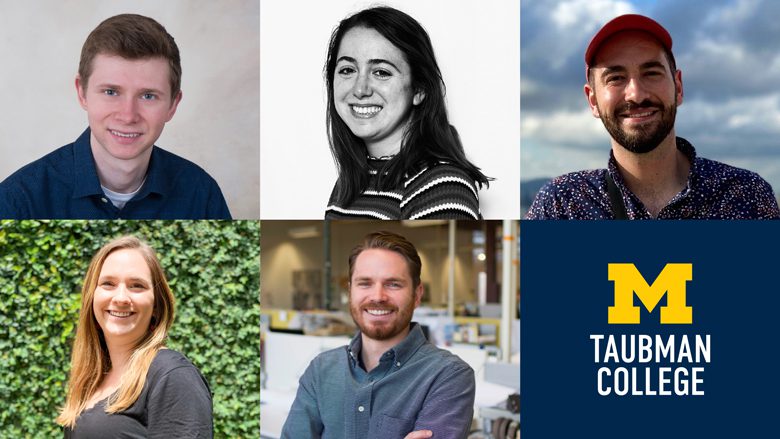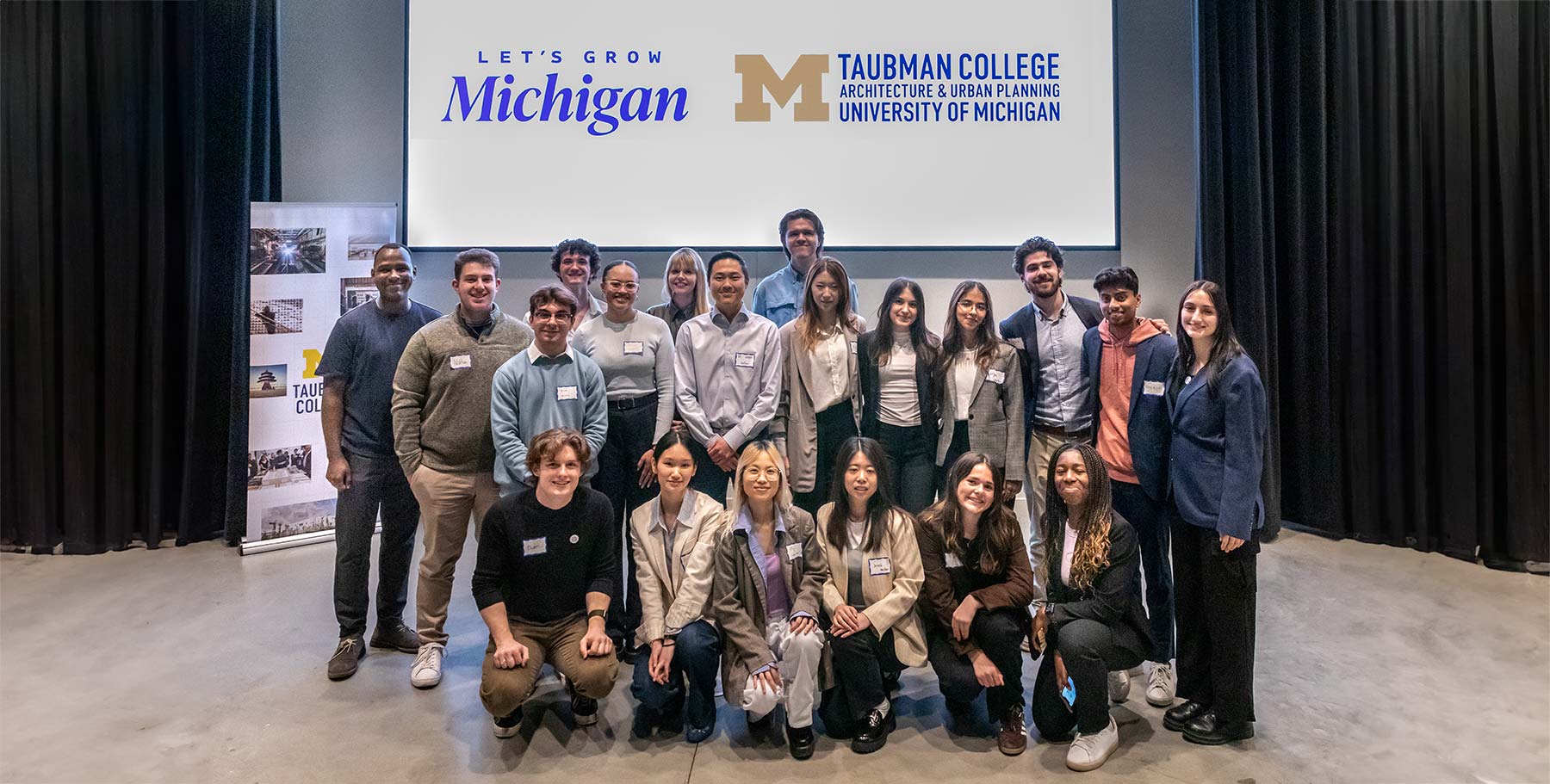A team of Taubman College students recently competed in the “Final Four” of the 2020 HUD Innovation in Affordable Housing student competition.
With the need for quality, affordable housing having never been greater, the competition, sponsored by the U.S. Department of Housing and Urban Development (HUD), is designed to encourage research and innovation in affordable housing, to raise practitioner and future practitioner capacity, and to foster cross-cutting teamwork within the design and community development process. The Taubman College team consisted of Josh Childs (M.U.R.P./M.P.P.), Bryan Hicks (M.Arch), Sam Kollar (M.U.R.P.), Amelia Linde M.Arch/M.U.D.), and Jess Yelk (M.Arch/M.U.R.P.).
The 2020 challenge focused on Santa Fe, New Mexico, which is one of the fastest-growing small cities in the United States. Like other cities of all sizes, Santa Fe faces an affordability crisis and needs thousands of new rent-restricted units to balance its current affordability deficit, “so from the start, we knew we wanted to design a project at the greatest scale allowed by current zoning in order to bring as many new affordable units as possible,” said Childs. “In the competition design brief, the Santa Fe County Housing Authority specified the desire to build units that would be suitable for single mothers with children. Given that request and Santa Fe’s aging population, we designed with seniors and children in mind.”
In Phase I of the competition in February, more than 200 teams from graduate programs nationwide submitted project proposals that included site plans and architectural renderings, a development budget and pro forma, and a narrative essay that focused on the innovative aspects of the design and finances. In late February, the Taubman College team found out that they had advanced to the finals, along with teams from the University of Maryland; the University of California, Berkeley; and Yale University.
After receiving judges’ feedback on their Phase I submissions, Hicks, Kollar, and Linde traveled to Santa Fe the first week of March to meet with the housing authority and see their project’s site firsthand. “I learned so much about the development process from this competition,” said Kollar. “But I especially learned how varied the affordable housing design process can be based on location. While most cities in the country are facing a housing crunch, the form the project assumes and the amenities needed to create a successful project are so place-specific.”
The whole team then worked to incorporate the judges’ feedback and insights gained from the Santa Fe trip to create a presentation of their revised work. With COVID-19 shutting down the in-person competition in Washington, D.C., the group made their case virtually instead. “One of the ways we adjusted was to try to come up with really engaging pieces in the presentation since we couldn’t be there in person, like an animated walk-through of our project,” Yelk said.
Childs participated in the competition in 2019; because it was such a fun learning experience, he decided to do it again in 2020. His new team formed organically through existing friendships: Childs and Yelk knew each other from class, but as a dual-degree student, Yelk also knew fellow architects Linde and Hicks. Childs and Kollar are in the same urban planning cohort. “The HUD competition requires interdisciplinary teams from at least three graduate programs and together, we represented four. Beyond that, we had complementary skill sets in passive design, sustainability modeling, housing policy, real estate finance, architectural rendering, graphic design, etc., that made us a very well-balanced team,” said Childs.
“I think the fact that our team is a group of friends really allowed us to work well together,” added Yelk.
Beyond the personal camaraderie, the competition was an opportunity to work with a different set of classmates in a non-studio setting. “There is so much to be learned on an interdisciplinary team, and when I was asked to join, I had to say yes,” said Linde. “I have been wanting to gain experience with designing affordable housing with the real-life financing that allows it to happen, so I saw HUD as an opportunity to learn and produce something beautiful.”
And something grounded in reality, added Yelk: “In studio, we design really cool buildings, but there is no client, no budget, no planners, no engineers. While it holds real value, it is very different from the real world. This competition was an opportunity to blend the two — to ground a design project with a client and budget, and learn more about what forms decisions from that end while still getting to have some fun.”
The experience also provided an opportunity to explore career paths, said Kollar: “I hope to start a career in affordable housing, so this seemed like a great opportunity to learn about and network within the field.”
Throughout the process, the team worked closely with Taubman College faculty. Lan Deng, associate professor of urban and regional planning, served as the team’s official adviser. “Through careful market research and site analysis, our students crafted a proposal that, as they stated themselves, is environmentally sustainable, socially inclusive, financially sound, and locally integrated,” Deng said. “What was truly unique about our team was their forward thinking and broader community perspective, which led to a proposal that would not only create high-quality affordable housing on site but also offer a vision for future development possibilities in the surrounding areas.”
Claudia Wigger, a lecturer in architecture, provided critiques of the architectural plans. Lecturer in Architecture Christina Hansen and Marc Norman, an associate professor of practice in urban and regional planning, provided feedback throughout the competition, especially with regard to the final presentation slides.
“The support from Taubman faculty has been tremendous. We were lucky to have so many faculty with such varied experience and perspective lend their time to helping us strengthen our work,” said Childs.
Although the team did not win the top prize, they are rightfully proud of their top-four finish and say the experience provided a valuable experience.
“The HUD competition has been my most enriching learning experience in all of graduate school,” Childs said. “The challenge of designing an affordable housing project from the ground up touches on so many subject areas. If nothing else, the experience taught me how incredibly complex and difficult it can be to make these affordable projects work.”
Faculty praised the students’ achievement, especially within the larger context of the competition’s timing. Said Norman, “Our students juggled end-of-semester work and the COVID-19 crisis; with all of that they crafted a thoughtful and innovative proposal applying their skills in a very unique and nuanced geography. The competition is a great showcase of Taubman College and the acuity of our students.”





